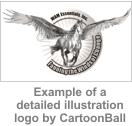design brief
See brief
 
detailed illustration
 Many online logo design companies make a distinction between "normal logos" (whatever that is!) and detailed logos or logos that require detailed illustration. Because of the way that computers and logo design software work, creating precise geometric shapes is achieved easily, while detailed work - like drawing a clump of trees for example - takes a lot of time to do properly. Many online logo design companies make a distinction between "normal logos" (whatever that is!) and detailed logos or logos that require detailed illustration. Because of the way that computers and logo design software work, creating precise geometric shapes is achieved easily, while detailed work - like drawing a clump of trees for example - takes a lot of time to do properly.
Typically online logo designers would have a one logo design package for normal business logos and one for detailed illustation, cartoon logos, mascot logos etc.
Thanks to CartoonBall for the example.
Further Reading:
Larger version of pegasus logo; http://www.cartoonball.com/pegasus.shtml
 
dingbat
 There are many fabulous tools that logo designers can use to create great logos in a short amount of time. There are many fabulous tools that logo designers can use to create great logos in a short amount of time.
Dingbats do not fall into that group.
Dingbats are basically clip art images packaged as fonts. Because dingbats usually represent standard icons and are freely available they should not be used as logos or even as inspiration for logos. Apart from the obvious ethical issue the images may also be copyrighted. Even if the image used is not protected by copyright the client will likely not be able to register the dingbat logo as a trademark.
 
DIY logo
A DIY logo, as the name suggests, is where the client becomes the designer, aided by some or other technology that supposedly makes it easy for anyone to design his or her own logo.
The online DIY logo idea is about as old as the pre-designed logo idea, but has not caught on to the same extent. This is partly due to the fact that building a DIY logo system is more difficult, but also at least in part due to the fact that the resulting logos are seldom on a par with professionally designed logos.
A further problem is that DIY logos generally make use of clip art images* which are then modified by the client via the DIY logo system. Because the starting point is defined and the options limited with regard to customization, it is inevitable that repitition will eventually occur in any DIY logo system. The older the system, the more likely it is that the logo you end up with will be exactly what someone else ended up with.
* typically custom clip art is used, but it is re-used images nonetheless
 
draft
While this term in the logo design context might refer to a pint of beer, it is more commonly used to refer to a batch of concept designs presented to a client.
Draft images can also refer to rough concept sketches, as opposed to cleaned up, print-ready final logo images.
 
drop shadow
See shadow for an explanation of different shadow types.
 
dynamic logo
 Dynamic logos are logos that change from time to time, using a strong central theme or character to bind the different logos together. The simplicity and recognizability of the Apple logo, for example, allows Apple Computer, Inc. to play with variations of the logo as the situation requires. Dynamic logos are logos that change from time to time, using a strong central theme or character to bind the different logos together. The simplicity and recognizability of the Apple logo, for example, allows Apple Computer, Inc. to play with variations of the logo as the situation requires.
Probably the main drawback with a dynamic logo is that it dilutes the brand. Instead of a single, strong, recognizable image the company has many. While this is not a serious problem for larger corporations who has the marketing capacity to get their logo(s) seen by millions, small companies generally strive to increase brand impact through consistency.
 The concept of dynamic logos is not new (Michelin in 1898 started the trend with their Michelin Man), but the fact that only a handful of larger companies could make it work for them is testament to the branding challenges that come with dynamic logos. The concept of dynamic logos is not new (Michelin in 1898 started the trend with their Michelin Man), but the fact that only a handful of larger companies could make it work for them is testament to the branding challenges that come with dynamic logos.
 
|


